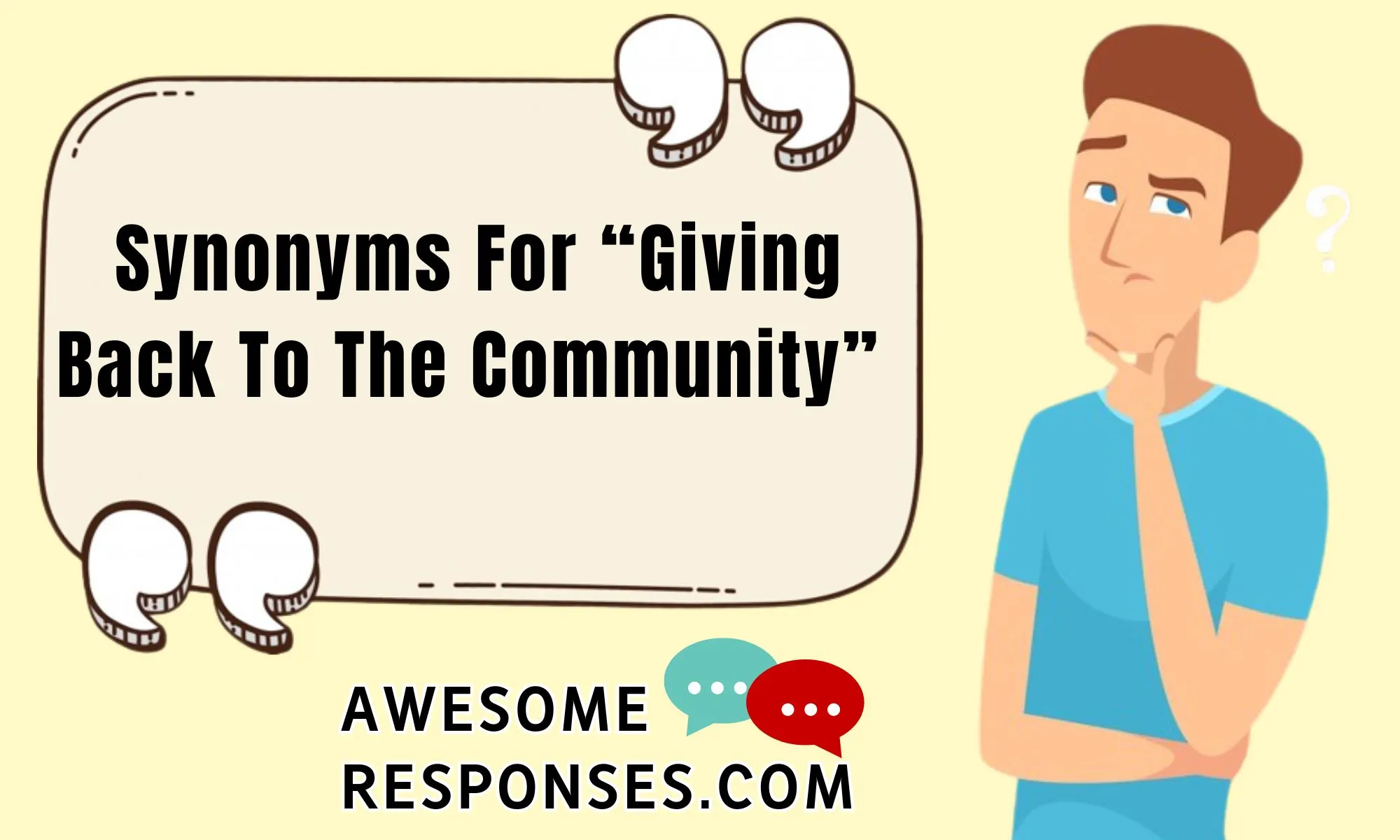In a world that thrives on interconnectedness, the essence of community engagement and giving back has never been more crucial. As individuals, we are not merely inhabitants of physical spaces but integral parts of the social fabric.
The act of contributing to the community transcends the realms of altruism and ventures into the terrain of shared responsibility.
This article explores 30 diverse ways to express the noble endeavor of giving back to the community, each term reflecting a unique facet of this profound commitment.
List of 30 Synonyms For “Giving Back To The Community”
- Contributing to the community
- Community service
- Volunteering
- Philanthropy
- Civic engagement
- Social responsibility
- Community outreach
- Charitable work
- Community involvement
- Public service
- Altruistic efforts
- Community support
- Charity work
- Social giving
- Community investment
- Outreach initiatives
- Helping the community
- Community development
- Supporting local causes
- Civic participation
- Grassroots involvement
- Benefiting the community
- Serving the community
- Community empowerment
- Neighborhood assistance
- Making a community impact
- Participating in community building
- Providing community aid
- Engaging in community betterment
- Offering community assistance
1. Community Service:
Engaging in community service is a fundamental way individuals dedicate their time and skills to uplift their surroundings. Whether through organized projects or personal initiatives, the ethos remains the same – a dedication to the collective welfare.
Example: John devoted his weekends to community service, cleaning up local parks and organizing educational workshops for the youth.
2. Volunteering:
The spirit of volunteering encapsulates the idea of selflessly offering one’s time and expertise. Volunteers play a pivotal role in addressing community needs, fostering a sense of unity and shared responsibility.
Example: Samantha has been volunteering at the local soup kitchen, ensuring that no one in the neighborhood goes hungry.
3. Philanthropy:
Philanthropy involves the generous donation of resources, be it financial or material, to uplift communities. It’s a powerful means to create sustainable change and address systemic issues.
Example: The billionaire’s act of philanthropy included funding scholarships for underprivileged students and supporting healthcare initiatives in underserved areas.
4. Civic Engagement:
Civic engagement goes beyond individual actions, encompassing the active participation of community members in decision-making processes. It empowers individuals to shape the future of their locality.
Example: The town hall meeting encouraged civic engagement, allowing residents to voice their opinions on crucial matters affecting the community.
5. Social Responsibility:
Acknowledging and fulfilling one’s social responsibility involves recognizing the impact of personal actions on the broader community. It emphasizes ethical behavior and a commitment to societal well-being.
Example: The company embraced a culture of social responsibility, implementing eco-friendly practices and supporting local initiatives.
6. Community Outreach:
Community outreach is a proactive approach to connect with residents. It involves reaching out to understand their needs, concerns, and aspirations, fostering a sense of inclusivity and support.
Example: The local church initiated a community outreach program, providing assistance to vulnerable families during challenging times.
7. Charitable Work:
Engaging in charitable work implies contributing resources, time, or efforts to address specific needs within the community. It’s a tangible expression of compassion and solidarity.
Example: Every year, the organization organizes a week of intense charitable work, aiding various causes from education to healthcare.
8. Community Involvement:
Being actively involved in the community means participating in events, discussions, and initiatives that impact the neighborhood positively. It fosters a sense of belonging and shared identity.
Example: Jack’s community involvement extended to coaching youth sports teams, creating a positive impact on the next generation.
9. Public Service:
Public service is a formal commitment to work for the betterment of society. It often involves employment in government or non-profit sectors with the primary goal of serving the community.
Example: After retirement, Sarah chose a path of public service, working in a local government office to address community needs.
10. Altruistic Efforts:
Altruistic efforts embody selflessness and a genuine concern for the well-being of others. Acts driven by pure altruism seek no personal gain but aim to enhance the lives of those in need.
Example: The anonymous donor’s altruistic efforts included funding the construction of a community center for the old people.
11. Community Support:
Community support involves standing by fellow residents during challenging times. It could be emotional, financial, or logistical assistance that reinforces a sense of unity.
Example: During the recent natural disaster, neighbors rallied together, offering community support to rebuild homes and lives.
Read More: Best Replies When Someone Says “Happy New Month”
12. Charity Work:
Similar to charitable work, charity work focuses on actively participating in activities or projects aimed at addressing specific community needs.
Example: The youth group organized a weekend of charity work, collecting donations for the local homeless shelter.
13. Social Giving:
Social giving signifies contributing to societal well-being through various means, promoting a culture of generosity and shared responsibility.
Example: Online platforms have made social giving more accessible, allowing individuals to contribute to causes globally.
14. Community Investment:
Community investment implies dedicating resources, both financial and non-financial, with the expectation of long-term positive returns for the community.
Example: The city’s strategic community investment plan focused on infrastructure development, education, and healthcare.
15. Outreach Initiatives:
Engaging in outreach initiatives involves actively seeking opportunities to connect with and support the community. It’s a proactive approach to address evolving needs.
Example: The environmental club initiated outreach initiatives to educate residents on sustainable living practices.
16. Helping the Community:
The simple act of helping the community encompasses a wide range of actions, from lending a hand to providing guidance or resources.
Example: Neighbors took turns helping the community, whether through small acts like mowing lawns or organizing neighborhood watch programs.
17. Community Development:
Community development is a comprehensive, long-term approach to enhance the overall well-being of a community. It encompasses economic, social, and environmental aspects.
Example: The urban renewal project aimed at holistic community development, focusing on affordable housing and job creation.
18. Supporting Local Causes:
Prioritizing and actively supporting local causes involves championing initiatives that directly impact the immediate community, fostering a sense of collective ownership.
Example: Businesses can play a crucial role by supporting local causes, such as sponsoring youth sports teams or investing in local infrastructure.
19. Civic Participation:
Civic participation is the active involvement of individuals in the political, social, and cultural aspects of their community. It empowers citizens to shape their shared destiny.
Example: Voter turnout is a key indicator of high levels of civic participation, reflecting an engaged and informed community.
20. Grassroots Involvement:
Grassroots involvement emphasizes the power of local, community-driven initiatives. It recognizes that impactful change often starts from the ground up.
Example: The community garden project exemplifies the strength of grassroots involvement, transforming vacant lots into vibrant green spaces.
21. Benefiting the Community:
Benefiting the community is the overarching goal of all giving back endeavors. It encapsulates the positive impact that various actions can have on the collective welfare.
Example: The urban art project aimed at benefiting the community by beautifying public spaces and fostering a sense of pride.
22. Serving the Community:
Actively serving the community involves taking on roles or responsibilities that contribute to the well-being of residents. It’s about being a proactive agent of positive change.
Example: Teachers extend beyond classrooms, serving the community by organizing educational workshops and mentorship programs.
23. Community Empowerment:
Community empowerment focuses on equipping individuals and groups with the tools and knowledge needed to actively participate in shaping their own destiny.
Example: The financial literacy program aimed at community empowerment, providing residents with the skills to manage their finances effectively.
24. Neighborhood Assistance:
Offering neighborhood assistance implies being attuned to the specific needs and challenges of the local area, providing targeted support where it matters most.
Example: The neighborhood watch program exemplifies the importance of neighborhood assistance, ensuring the safety and well-being of residents.
25. Making a Community Impact:
Making a community impact goes beyond mere participation; it signifies actively contributing to positive changes that leave a lasting imprint on the community.
Example: The environmental cleanup initiative was successful in making a community impact, enhancing the overall quality of life.
26. Participating in Community Building:
Actively participating in community building involves engaging in activities that foster a sense of unity, trust, and collaboration among residents.
Example: The community potluck dinners play a crucial role in participating in community building, strengthening social bonds.
27. Providing Community Aid:
Providing community aid is a tangible expression of support, offering assistance to those in need, whether during crises or as part of ongoing efforts.
Example: Emergency response teams play a vital role in providing community aid, offering immediate assistance during disasters.
28. Engaging in Community Betterment:
Actively engaging in community betterment involves identifying areas for improvement and actively working towards enhancing the overall quality of life for residents.
Example: The urban renewal project focused on engaging in community betterment, revitalizing neglected areas and creating vibrant public spaces.
29. Offering Community Assistance:
Offering community assistance is a proactive approach to meeting the needs of residents, recognizing that a helping hand can make a significant difference.
Example: Local businesses can contribute by offering community assistance, whether through job training programs or financial support for local initiatives.
30. Advocating for Community Well-Being:
Advocating for community well-being involves being a vocal proponent for policies, initiatives, and practices that prioritize the health and prosperity of the community.
Example: Environmental activists dedicate their efforts to advocating for community well-being, pushing for policies that ensure clean air and water for all.
Conclusion:
In the tapestry of human connection, the threads of giving back to the community weave a narrative of shared responsibility, compassion, and empowerment. The rich tapestry of terminology explored in this article illustrates the depth and diversity of actions that individuals and groups can take to contribute positively to the communities they call home.
Whether through formal avenues like public service or the grassroots efforts of neighborhood assistance, each term represents a unique color contributing to the vibrant mosaic of communal well-being.
As we navigate the complexities of modern life, let us be mindful of the myriad ways we can actively participate in creating stronger, more resilient, and interconnected communities.

I’m Ethan Richards, the guy orchestrating the awesomeness at “Awesome Responses.” I’ve been turning ordinary replies into extraordinary ones, making the art of quick responses a whole lot of fun. Over at Awesome Responses, we’re here to make your replies incredible. Let’s add some wit and humor to your response game together!













